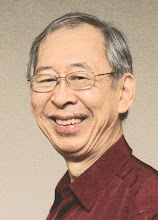
This complex painting needs a bit of explanation. Ideally, to see the eight sectors of this round composite painting well on the computer, you'd need to rotate your r screen. It is not planned to be hung up vertically on the wall like other paintings. Instead, it is planned to look like a round ceiling painting. The viewer stands underneath at the centre looking up facing outwards while rotating.
In reality, the oil painting is to be hung facing down underneath the ceiling. It is built up of four square stretched canvas paintings joined together. The total size is 6 x 6 ft.
In terms of content, the painting is built up from four pairs of paintings of scenes that are viewed from above. Each painting pair shows two contrasting scenes, or scenes before and after disasters. Together, they serve to illustrate how upside down the world can be, arising from recent events.
On the top left of the photo above, the painting pair shows our world's rich poor divide. One of them shows the glittering night scene of the gambling/entertainmemt city Las Vegas. The other shows the tents at a crowded refugee camp where people including women and children are living in subsistence conditions.
The painting pair on top right shows people and their crops in poor countries are badly affected by bad climate conditions, either severe drought or deadly flooding.
The painting pair on botom right shows a over-crowded over-loaded ferry boat with a few hundred on board before and after it was overturned by stormy seas drowning many on board.
On bottom left, the painting pair shows the New York World Trade Centre Twin Towers before and after they were attacked causing the two tall buildings to burn and collapse completely. A few thousand people died from this horrid event.














